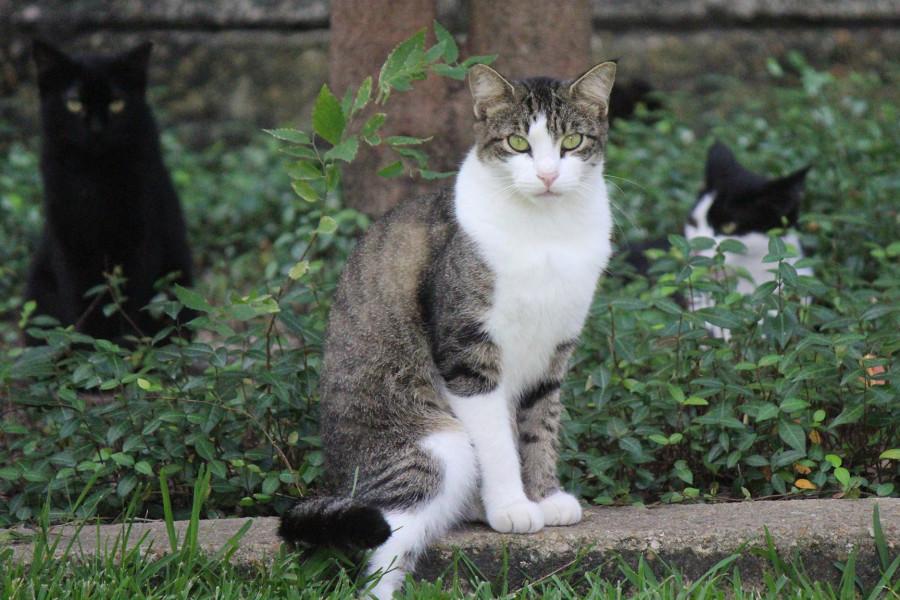Neuter program fixes feral cat overpopulation
Three feral cats roam in front of Percival Stern Hall at Tulane University. The cat population has slowly declined in the Uptown area due to neuter programs. Photo credit: Kristen Stewart
October 25, 2015
As the years passed by, he grew closer to his neighbor. In return for food and a warm place to sleep on cold or rainy nights, he got rid of his neighbor’s rodents and provided the occasional cuddle.
Janet Winchell, Kiro’s neighbor, said that she enjoyed having his presence nearby.
“He was here when I moved in about a year ago. I look out for him because he has no one else to care for him,” Winchell said. “He is my friend.”
Kiro the Cat is one of the hundreds of neutered feral cats that roam the streets of New Orleans.
However, according to the data provided by the Louisiana Society for the Prevention of Cruelty to Animals, there has been a 56 percent decrease in cats brought in from trap-neuter-return program in the Uptown area from 2011 to 2013 and the numbers are still steadily decreasing.
While some members of the community appreciate cats like Kiro, others, such as Bre Castex, feel like cats in Uptown are more of a pest than a friend.
“We actually have a neighbor who feeds not one but 11 feral cats that live in our neighborhood,” Castex said. “A litter of cats were born under the house about two years ago. They were using our house as their home and kind of their safe area.”
Castex didn’t have the same experience with the kittens as Winchell had with Kiro.
“After a year, we ended up having fleas that were coming up through our floor boards,” Castex said. “We ended up having to move out of the house on two separate occasions to have pesticide sprayed. Ultimately, we had to get an exclusion fence around the bottom of the house to keep them from the house and spreading the fleas.”
Louisiana law states that it is legal to feed cats on private property as long as they are neutered. Kiro and the cats that lived under Castex’s home find themselves sharing the neighborhood with Uptown residents.
According to Heather Rigney, feral cat coordinator for the LASPCA, feral cats can not be removed from their environment because they are a form of natural pest control.
“If you get rid of all those cats, not only will you end up with a new batch a few months later, but you are going to end up with rats running across the streets as well,” Rigney said.
Rigney said one reason why there may appear to be an overabundance of cats on the street is because of the transitory nature of the Uptown area and overfeeding.
“In the Uptown area, you have a lot of transient renters and college students who have a pet for a couple of years and they move to a different state, and well there goes kitty,” Rigney said.
Melanie Fawler, an independent cat trapper, said that the trap-neuter-return program may be the best solution to cutting down the cat population in Uptown.
“I started to catch and release because I didn’t want to give them to the LASPCA to be euthanized,” Fawler said. “These are living, breathing creatures and animals share nothing but love. I think that everyone just needs to do their part and not just dump them at the SPCA and make them their problem.”
While Alicia Haefele, communications director for the LASPCA, said that it is nearly impossible to track the amount of feral cats in the community, with the LASPCA’s trap-neuter-return program, they have fixed more than 17,000 feral cats and have prevented the birth of nearly 116,000 kittens.
Rigney said that because people are more active in getting cats fixed, not only are there fewer cats on the street, but also fewer cats in the shelter as well.
“Whether there are more cats or less cats is anyone’s guess, but our clinic does approximately 3,000 cat surgeries every year. More people are buying into the cat neuter return program than 10 years ago, which helps our goal of fixing so many cats that we start to see a decline in intakes of cats, especially kittens, off the streets,” Rigney said.









J van de Woestijne • Oct 26, 2015 at 3:09 pm
TNR programs fail because they do not operate in an enclosed system and cannot spay or neuter a sufficient number of cats to affect feral cat numbers at the population level. Despite the good intentions of many involved in TNR programs, TNR has been found to be a waste of time, money, and resources.
Once feral cats are spayed or neutered, they are then abandoned back into the environment to continue a feral existence. Not only is this systematic abandonment inhumane to the cats, it perpetuates numerous problems such as wildlife predation, transmission of disease, and property destruction. For more info look at the cats indoors program http://abcbirds.org/program/cats-indoors/trap-neuter-release/